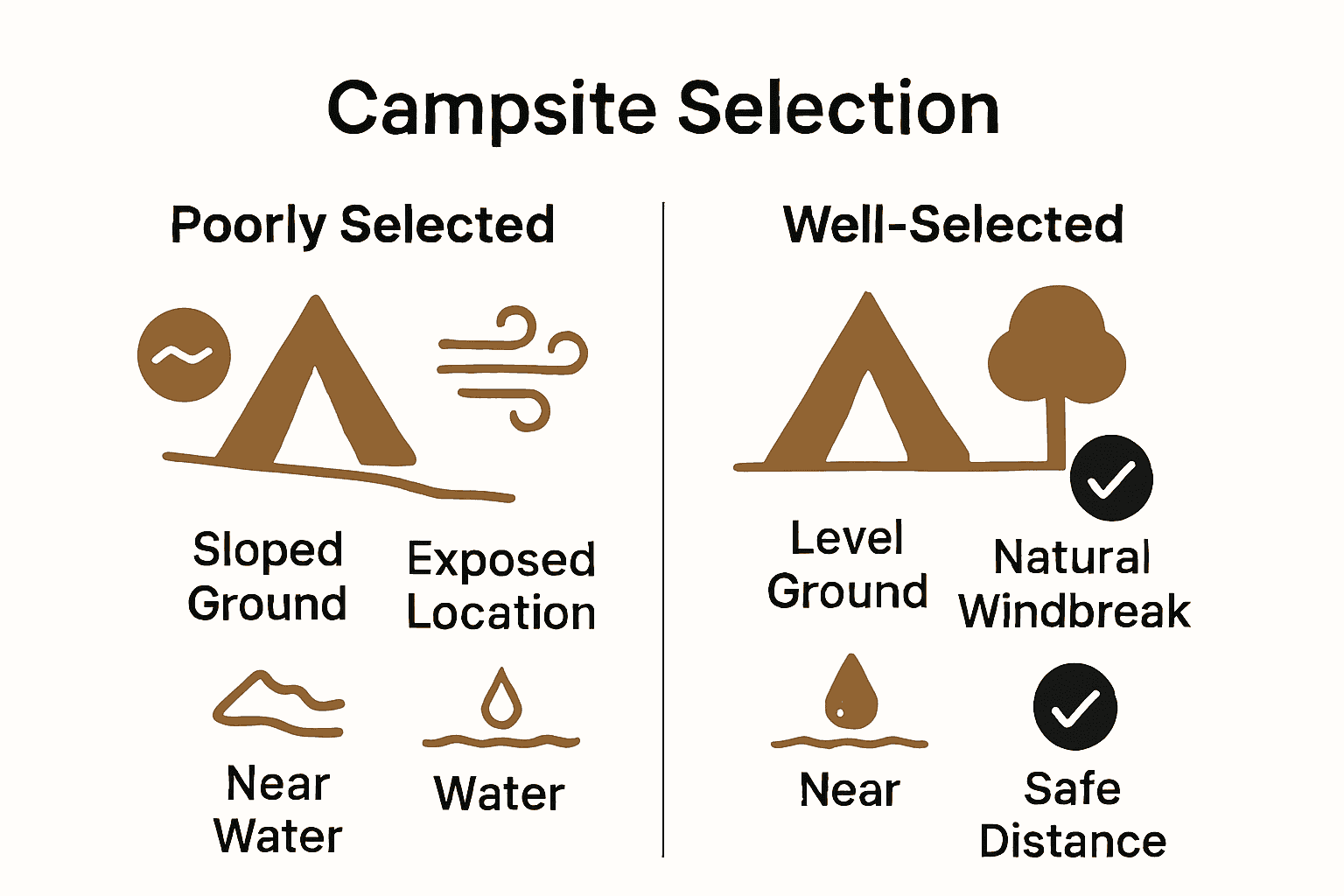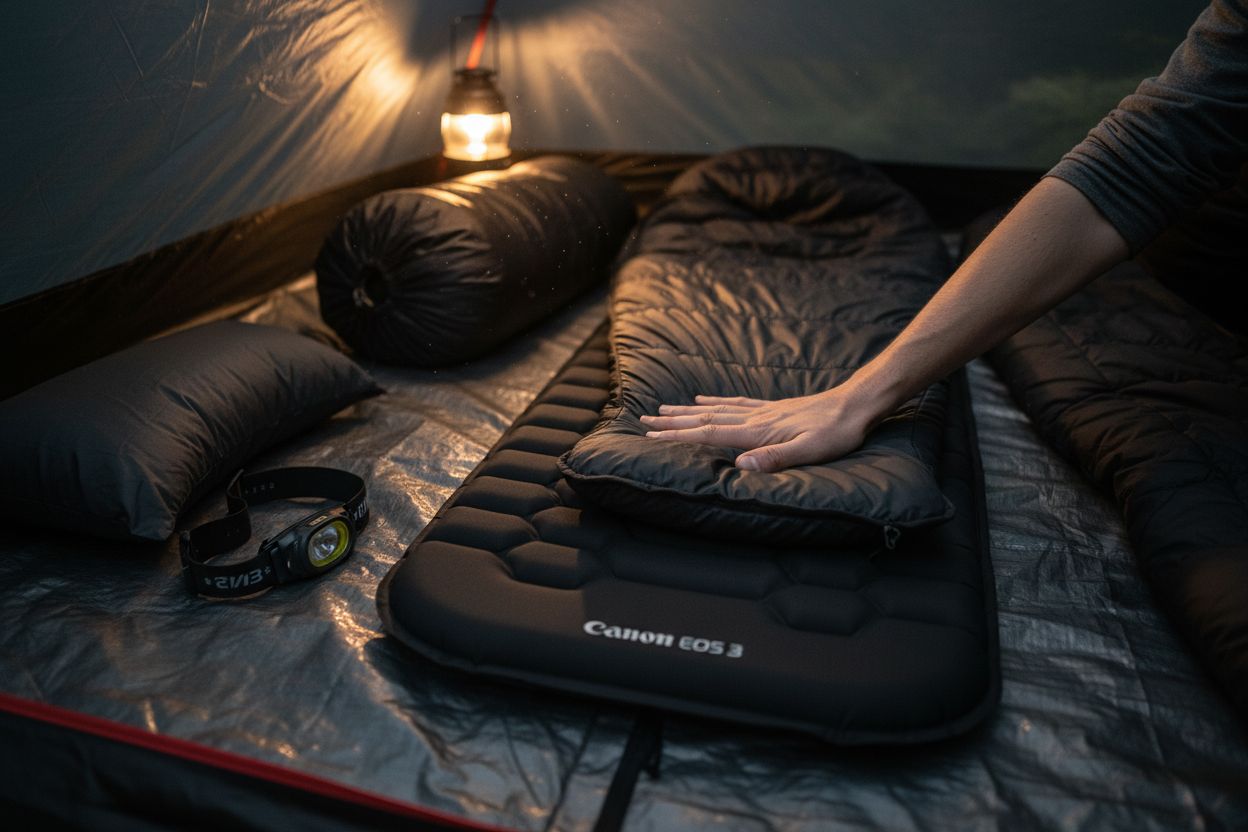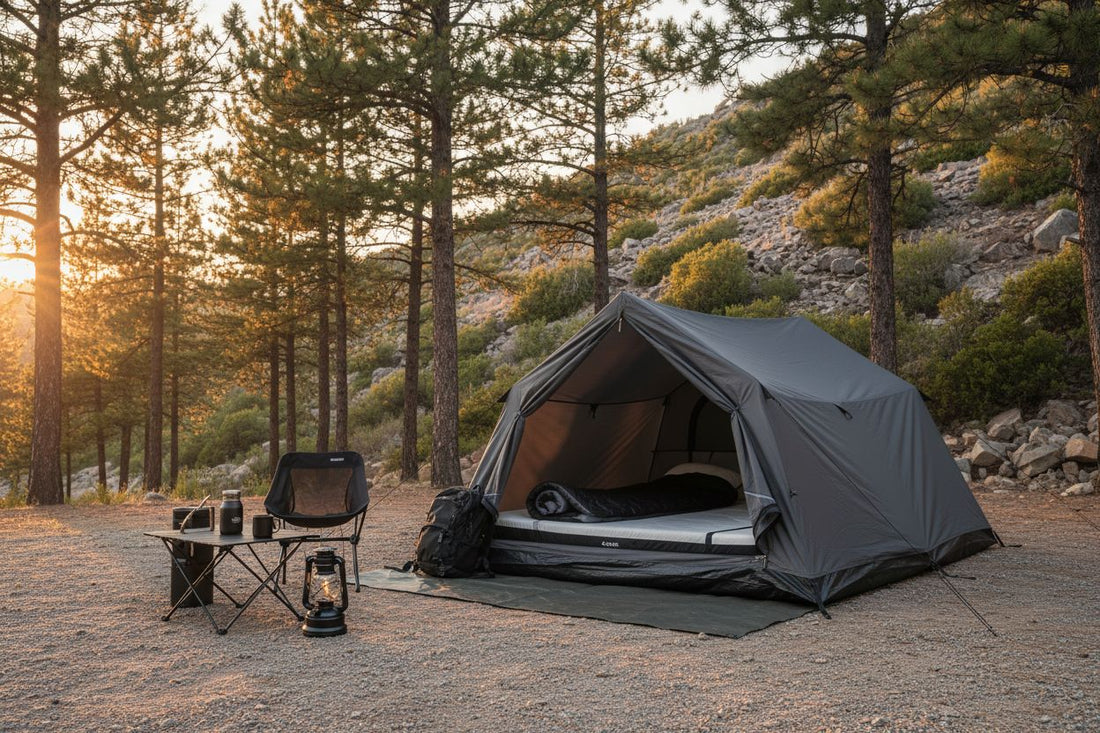Did you know that over 70 percent of campers struggle with sleep quality their first night outdoors? Getting a full night’s rest can be surprisingly tough when you swap your bed for a sleeping bag. Where you camp, what you sleep on, and your nightly habits all directly influence your comfort outside. Simple adjustments to your campsite and routine can help you enjoy deeper, rejuvenating sleep under the stars.
Quick Summary
| Key Point | Explanation |
|---|---|
| 1. Choose Level Ground | Select a flat, level area for sleeping to avoid discomfort and sliding during the night. |
| 2. Ensure Wind Protection | Camp near natural windbreaks like hills or dense vegetation to maintain stable conditions while sleeping. |
| 3. Maintain Proper Distance from Water | Camp about 200 feet away from water sources to access them easily while preventing moisture issues. |
| 4. Create a Comfortable Sleeping Surface | Use a high-quality sleeping pad and ground tarp to provide insulation and cushioning against the cold ground. |
| 5. Establish a Consistent Night Routine | Wind down activities before bed to signal your body that it’s time to relax and prepare for sleep. |
Table of Contents
- Step 1: Select The Ideal Campsite Location
- Step 2: Prepare A Comfortable Sleeping Surface
- Step 3: Optimize Your Sleeping Gear
- Step 4: Establish An Effective Night Routine
- Step 5: Evaluate And Adjust For Better Sleep
Step 1: Select the Ideal Campsite Location
Choosing the right campsite is your first crucial step toward getting natural, restful sleep during your outdoor adventure. The location you select will dramatically impact your comfort and sleep quality.
When searching for your perfect campsite, prioritize finding a level ground area that provides protection from wind and potential natural disruptions. According to camping experts at Backpacker, selecting a level surface free of rocks and sticks is essential for relaxation and sleep comfort.
Start by carefully surveying the terrain. Look for a flat area without significant slopes that could cause you to slide during the night. Walk the potential site and feel the ground with your feet. Remove any sticks, rocks, or pinecones that might create uncomfortable pressure points. Using a ground tarp underneath your sleeping area can provide an extra layer of protection and smoothness.
Pro Tip: Avoid setting up camp directly under trees with weak or dead branches that could potentially fall during windy conditions or overnight.
Pay attention to wind patterns and natural windbreaks. Seek locations near larger rocks, small hills, or dense vegetation that can shield your campsite from strong gusts. This natural protection helps maintain a more stable sleeping environment and reduces nighttime temperature fluctuations.
Consider proximity to water sources while maintaining a safe distance. You want convenient access to water for cooking and cleaning, but not so close that moisture or potential animal traffic disrupts your sleep. Generally, staying 200 feet away from water sources is a good rule of thumb.
As you finalize your campsite selection, take a moment to observe the ground for potential drainage issues. Slight elevation can prevent water pooling in case of unexpected rain. Your goal is creating a comfortable, safe sleeping environment that supports natural rest and outdoor enjoyment.

Here’s a summary of top campsite selection factors and their benefits:
| Factor | Why It’s Important | Practical Tips |
|---|---|---|
| Level Ground | Prevents sliding, relieves pressure points | Walk the site Clear rocks & sticks |
| Wind Protection | Ensures stable sleep conditions | Use natural windbreaks (rocks, hills, vegetation) |
| Water Proximity | Easy access but avoids moisture/animals | Camp ~200 ft from water |
| Tree Safety | Reduces risks from falling branches | Avoid weak/dead limbs overhead |
| Drainage/Elevation | Prevents water pooling in rain | Choose slightly elevated spots |
Next, you will learn how to prepare your actual sleeping area to maximize comfort and ensure a great night’s sleep under the stars.
Step 2: Prepare a Comfortable Sleeping Surface
Creating a comfortable sleeping surface transforms your outdoor sleeping experience from merely surviving to genuinely enjoying the night under the stars. Your goal is to build a sleeping area that keeps you warm, cushioned, and protected from the ground.
According to Nest Bedding experts, investing in a high-quality sleeping pad and appropriate sleeping bag is crucial for outdoor comfort. Start by selecting a sleeping pad with sufficient insulation from the cold ground. Look for pads with a good R-value rating, which measures thermal resistance.
Begin by laying down a ground tarp or footprint to create a moisture barrier between your sleeping area and the earth. This extra layer prevents dampness and adds an initial cushioning effect. Next, place your sleeping pad on top of the tarp. Inflate or unroll the pad carefully, ensuring it is fully expanded and free from any sharp objects or uneven surfaces.
Pro Tip: Test your sleeping pad before your camping trip to understand its comfort level and ensure it meets your specific needs.
Choose a sleeping bag rated for the expected temperature range of your camping destination. If you tend to get cold easily, opt for a bag with a lower temperature rating than you anticipate needing. Layer your sleeping bag with a lightweight thermal liner for additional warmth and comfort.
Our guide on camp bedding organization can help you optimize your sleeping setup and maximize the limited space in your tent. Consider using compression sacks to minimize the volume of your sleeping gear during transport.
Pay attention to your body’s positioning. Use additional soft items like a lightweight camping pillow or rolled clothing to support your neck and maintain proper spine alignment. Experiment with different arrangements until you find a setup that provides maximum comfort and support.

With your sleeping surface now prepared, you are ready to create a restful environment that will help you recharge for the next day’s adventures.
Step 3: Optimize Your Sleeping Gear
Preparing the right sleeping gear can make the difference between a miserable night and an incredible outdoor sleeping experience. Your goal is to create a personalized sleep system that adapts to changing outdoor conditions and keeps you comfortable.
According to Sea to Summit adventure experts, selecting the right sleeping bag material is crucial. Consider choosing between down and synthetic insulation based on your specific camping environment. Down provides excellent warmth for weight in dry conditions, while synthetic performs better in damp or humid environments.
Layering is key to temperature management. Start with a lightweight thermal liner inside your sleeping bag to add an extra layer of warmth. This approach allows you to adjust your sleeping system easily as temperatures fluctuate throughout the night. Bring an emergency reflective blanket as a backup insulation layer that can provide surprising warmth in unexpected cold snaps.
Pro Tip: Pack a compact compression sack to minimize your sleeping gear’s volume and make transportation easier.
Comfort goes beyond just temperature. Check out our guide on outdoor sleep solutions for additional strategies. Consider bringing a familiar pillow from home or investing in a quality camping pillow that provides neck support. Lightweight options like inflatable or compressible pillows work great for minimizing pack weight.
Address potential sleep disruptions by packing additional comfort items. Bring earplugs to block out unexpected nighttime sounds like wildlife or neighboring campers. An eye mask can help block ambient light and improve sleep quality, especially during summer months with extended daylight.
Always test your sleeping gear before your trip. Practice setting up your sleeping system at home to understand how different layers work together and identify any potential issues. This preparation ensures you can make quick adjustments in the field and maximize your outdoor sleeping comfort.
With your sleeping gear optimized, you are now ready to create a personalized sleep sanctuary that will help you rest and recharge during your outdoor adventure.
Step 4: Establish an Effective Night Routine
Creating a consistent nighttime routine transforms your outdoor sleeping experience from restless to restful. Your goal is to signal your body that it is time to wind down and prepare for a peaceful night under the stars.
Climbing magazine experts recommend stopping vigorous activities at least three hours before bedtime. This means winding down camp activities like hiking or setting up equipment well in advance of your intended sleep time. Your body needs time to transition from active exploration mode to a relaxed state.
Start by planning your evening meal earlier in the night. Allow sufficient time for digestion before sleeping. According to the Camping and Caravanning Club, camping naturally helps reset your internal body clock through exposure to natural light. Take advantage of this by aligning your routine with the sunset and embracing the natural rhythm of outdoor environments.
Pro Tip: Wear warm socks to help regulate body temperature and signal to your system that it is time to sleep.
Prepare a calming pre-sleep ritual that mimics your home routine. This might include drinking a warm herbal tea like chamomile, doing light stretches, or practicing simple breathing exercises. Avoid digital screens after sunset, as blue light can disrupt your natural sleep cycle. Instead, engage with your surroundings listen to ambient nature sounds or read a book by lantern light.
Hydration is important but time it carefully. Drink plenty of water during the day but reduce intake in the hours leading up to bedtime to minimize nighttime bathroom trips. Consider bringing melatonin supplements if you struggle with sleep adaptation in new environments.
Create a consistent wind down sequence. Change into sleeping clothes, organize your sleeping area, and do a final check of your campsite. These repetitive actions help signal to your body that sleep is approaching, making the transition easier.
With your nighttime routine established, you are now ready to embrace a peaceful and rejuvenating sleep under the open sky.
Step 5: Evaluate and Adjust for Better Sleep
Improving your outdoor sleeping experience is an ongoing process of mindful observation and gentle adaptation. Your goal is to understand your body’s unique responses to the camping environment and make small adjustments that enhance your overall rest.
Research from sleep and nature experts reveals that camping naturally resets our circadian rhythms through exposure to natural light, reduced artificial stimulation, and increased physical activity. Pay attention to how your body responds during each night of camping and use these insights to refine your sleeping strategy.
Reframe your perspective on nighttime awakenings. According to the Camping and Caravanning Club, interrupted sleep is not a failure but a normal part of our natural sleep cycle. When you wake up, resist the urge to feel frustrated. Instead, use these moments as opportunities for quiet reflection, gentle stretching, or even stargazing.
Pro Tip: Keep a small journal to track your sleep patterns and comfort levels throughout your camping trip.
Our guide on memory foam mattress setup can provide additional insights into creating an optimal sleep environment. Listen to your body and make incremental changes. If you find yourself feeling cold, add an extra layer. If you are too warm, adjust your clothing or ventilation.
Practice mindfulness techniques to enhance your sense of safety and connection with your environment. Deep breathing exercises and progressive muscle relaxation can help calm your mind and signal to your body that it is safe to rest. Focus on the natural sounds around you wind rustling through trees, distant wildlife noises as a soothing backdrop.
Remember that adaptation takes time. Do not expect perfect sleep from the first night. Each camping trip is a learning experience that helps you understand your unique sleep needs in outdoor settings. Be patient with yourself and approach each night with curiosity and openness.
With these strategies, you are now equipped to create a more restful and enjoyable camping sleep experience.
Discover Outdoor Sleep Solutions Designed for Natural Comfort
Nature should help you rest—but uncomfortable nights on uneven ground or chilly, unsupportive bedding can turn your camping adventure into a struggle. If you are searching for reliable ways to improve camp sleep naturally, as discussed in our guide, you know how crucial it is to create the right sleeping surface and gear. Challenges like finding level ground, optimizing warmth, and preventing sore pressure points are real obstacles for anyone trying to wake up recharged outdoors.
The Hazli Collection is here to make outdoor comfort easy and dependable. Our high-quality memory foam mattresses, practical camping pillows, and thoughtfully designed sleep accessories help you build a camp sleep setup that feels like home. For extra tips on camp bedding setup, head to our camp bedding organization guide or explore how to create comfort with our detailed memory foam mattress setup guide. When you are ready to transform every night outdoors, browse our trusted sleep solutions at Hazli Collection and enjoy seamless shopping with reliable support.

Ready for real outdoor comfort? Find your ideal camping mattress and sleep gear today. Give your next adventure the restful nights you deserve by shopping now at Hazli Collection.
Frequently Asked Questions
How can I select the best campsite location for improved sleep?
Choosing a level ground area that is protected from wind is crucial for quality sleep. Look for flat, obstacle-free surfaces and ensure you’re about 200 feet away from water sources to avoid moisture disturbances.
What steps should I take to prepare a comfortable sleeping surface while camping?
To create a cozy sleeping area, lay down a ground tarp for moisture protection, then place a quality sleeping pad on top. Ensure your sleeping bag is rated for the expected temperature range to enhance warmth and comfort through the night.
How can I optimize my sleeping gear for a better night’s sleep outdoors?
Selecting the right sleeping bag material is key. Choose between down and synthetic insulation based on your camping conditions, and incorporate layers like thermal liners to adapt to fluctuating temperatures.
What should my nighttime routine include to promote restful sleep while camping?
Establish a consistent wind-down routine by engaging in calming activities such as stretching or enjoying herbal tea three hours before bed. Also, transition away from screens to allow your body to naturally prepare for sleep.
How can I evaluate and adjust my sleeping setup during a camping trip?
Pay attention to how your body responds each night and make small adjustments if you’re uncomfortable. If you’re feeling cold or too warm, modify your clothing layers or sleeping gear to improve comfort levels.
What mindset should I maintain if I wake up during the night while camping?
Rather than feeling frustrated, embrace nighttime awakenings as natural and take the opportunity for quiet reflection or light stretching. This approach helps you relax and can aid in falling back to sleep more easily.

